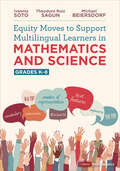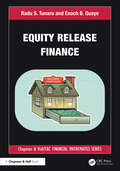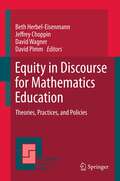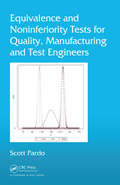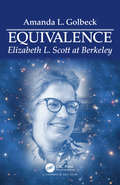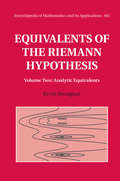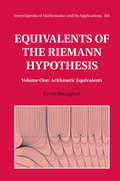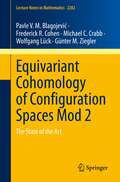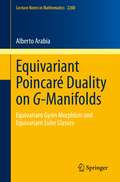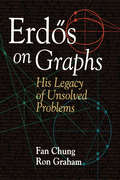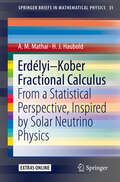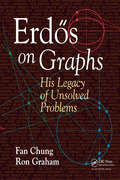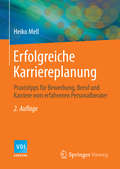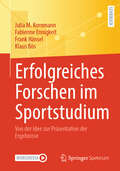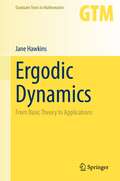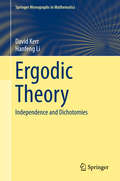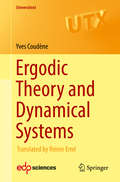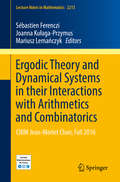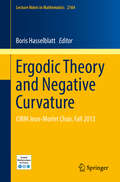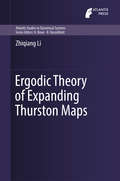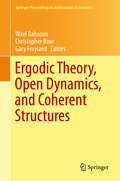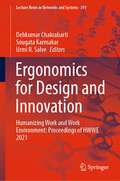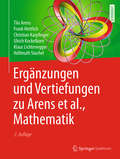- Table View
- List View
Equity Moves to Support Multilingual Learners in Mathematics and Science, Grades K-8 (Corwin Mathematics Series)
by Ivannia Soto Theodore Sagun Michael BeiersdorfA strengths and assets-based approach to multilingual learner success As the number of multilingual learners (MLLs) in US schools continues to grow, educators need to learn the moves necessary to support the success of these students in mathematics and science. Equity Moves to Support Multilingual Learners in Mathematics and Science, Grades K-8 focuses on the literacy opportunities that MLLs can achieve when language scaffolds are taught alongside rigorous math and science content. It provides a framework teachers can use to develop equity-centered, scaffolded math, science, or STEAM lessons. Readers will find Anchor phenomena that demonstrate issues with lesson design and delivery and highlight areas to include language and content scaffolds Examples for honoring the languages of students, families, and communities Culturally responsive techniques and easy-to-use tables featuring the equity moves Vignettes showcasing the equity move in the classroom setting A focus on four language demands: vocabulary, discourse, multiple modes of representation, and text features With an assets-based approach to what MLLs can do, this book helps teachers unpack the language demands of mathematics and science and encourages reflection of their own practices in scaffolding for language and culture.
Equity Release Finance (Chapman and Hall/CRC Financial Mathematics Series)
by Radu S. Tunaru Enoch B. QuayeEquity Release Finance provides a self-contained introduction to the principles underpinning Equity Release Products (ERPs). The approach of the book, while academically robust, is also accessible and engaging, with a focus on practical examples and applications. It will provide an invaluable resource to a diverse audience, including Master’s degree and PhD students in finance, management science, actuarial science, and risk management. It will also be of service to academics and industry professionals.Features A strong practical focus makes this an effective reference for industry professionals in the field of insurance, pensions, derivatives, and risk management Replete with pedagogical features, the book can be used to teach Master’s and/or PhD level graduate students The ideas presented in this book should be of interest to policy makers and regulators interested in developing a viable stable market, opening many avenues for further research in this area
Equity in Discourse for Mathematics Education
by David Wagner Beth Herbel-Eisenmann David Pimm Jeffrey ChoppinThis book explores the connection between the ways people speak in mathematics classrooms and their opportunities to learn mathematics. The words spoken, heard, written and read in mathematics classrooms shape students' sense of what mathematics is and of what people can do with mathematics. The authors employ multiple perspectives to consider the means for transformative action with respect to increasing opportunities for traditionally marginalized students to form mathematical identities that resonate with their cultural, social, linguistic, and political beings.
Equivalence and Noninferiority Tests for Quality, Manufacturing and Test Engineers
by Scott PardoIn engineering and quality control, various situations, including process validation and design verification, require equivalence and noninferiority tests. Equivalence and Noninferiority Tests for Quality, Manufacturing and Test Engineers presents methods for using validation and verification test data to demonstrate equivalence and noninferiority
Equivalence: Elizabeth L. Scott at Berkeley
by Amanda L. GolbeckEquivalence: Elizabeth L. Scott at Berkeley is the compelling story of one pioneering statistician’s relentless twenty-year effort to promote the status of women in academe and science. Part biography and part microhistory, the book provides the context and background to understand Scott’s masterfulness at using statistics to help solve societal problems. In addition to being one of the first researchers to work at the interface of astronomy and statistics and an early practitioner of statistics using high-speed computers, Scott worked on an impressively broad range of questions in science, from whether cloud seeding actually works to whether ozone depletion causes skin cancer. Later in her career, Scott became swept up in the academic women’s movement. She used her well-developed scientific research skills together with the advocacy skills she had honed, in such activities as raising funds for Martin Luther King Jr. and keeping Free Speech Movement students out of jail, toward policy making that would improve the condition of the academic workforce for women. The book invites the reader into Scott’s universe, a window of inspiration made possible by the fact that she saved and dated every piece of paper that came across her desk.
Equivalents of the Riemann Hypothesis: Analytic Equivalents (Encyclopedia of Mathematics and its Applications #165)
by Kevin BroughanThe Riemann hypothesis (RH) is perhaps the most important outstanding problem in mathematics. This two-volume text presents the main known equivalents to RH using analytic and computational methods. The book is gentle on the reader with definitions repeated, proofs split into logical sections, and graphical descriptions of the relations between different results. It also includes extensive tables, supplementary computational tools, and open problems suitable for research. Accompanying software is free to download. These books will interest mathematicians who wish to update their knowledge, graduate and senior undergraduate students seeking accessible research problems in number theory, and others who want to explore and extend results computationally. Each volume can be read independently. Volume 1 presents classical and modern arithmetic equivalents to RH, with some analytic methods. Volume 2 covers equivalences with a strong analytic orientation, supported by an extensive set of appendices containing fully developed proofs. Gives students and researchers easy access to methods and results. Fully describes approaches to the Riemann hypothesis using arithmetic functions. Provides many unsolved problems suitable for research. Tailored software is freely available online.
Equivalents of the Riemann Hypothesis: Arithmetic Equivalents (Encyclopedia of Mathematics and its Applications #164)
by Kevin BroughanThe Riemann hypothesis (RH) is perhaps the most important outstanding problem in mathematics. This two-volume text presents the main known equivalents to RH using analytic and computational methods. The book is gentle on the reader with definitions repeated, proofs split into logical sections, and graphical descriptions of the relations between different results. It also includes extensive tables, supplementary computational tools, and open problems suitable for research. Accompanying software is free to download. These books will interest mathematicians who wish to update their knowledge, graduate and senior undergraduate students seeking accessible research problems in number theory, and others who want to explore and extend results computationally. Each volume can be read independently. Volume 1 presents classical and modern arithmetic equivalents to RH, with some analytic methods. Volume 2 covers equivalences with a strong analytic orientation, supported by an extensive set of appendices containing fully developed proofs. Gives students and researchers easy access to methods and results. Fully describes approaches to the Riemann hypothesis using arithmetic functions. Provides many unsolved problems suitable for research. Tailored software is freely available online.
Equivariant Cohomology of Configuration Spaces Mod 2: The State of the Art (Lecture Notes in Mathematics #2282)
by Günter M. Ziegler Pavle V. Blagojević Frederick R. Cohen Michael C. Crabb Wolfgang LückThis book gives a brief treatment of the equivariant cohomology of the classical configuration space F(ℝ^d,n) from its beginnings to recent developments. This subject has been studied intensively, starting with the classical papers of Artin (1925/1947) on the theory of braids, and progressing through the work of Fox and Neuwirth (1962), Fadell and Neuwirth (1962), and Arnol'd (1969). The focus of this book is on the mod 2 equivariant cohomology algebras of F(ℝ^d,n), whose additive structure was described by Cohen (1976) and whose algebra structure was studied in an influential paper by Hung (1990). A detailed new proof of Hung's main theorem is given, however it is shown that some of the arguments given by him on the way to his result are incorrect, as are some of the intermediate results in his paper.This invalidates a paper by three of the authors, Blagojević, Lück and Ziegler (2016), who used a claimed intermediate result in order to derive lower bounds for the existence of k-regular and ℓ-skew embeddings. Using the new proof of Hung's main theorem, new lower bounds for the existence of highly regular embeddings are obtained: Some of them agree with the previously claimed bounds, some are weaker.Assuming only a standard graduate background in algebraic topology, this book carefully guides the reader on the way into the subject. It is aimed at graduate students and researchers interested in the development of algebraic topology in its applications in geometry.
Equivariant Poincaré Duality on G-Manifolds: Equivariant Gysin Morphism and Equivariant Euler Classes (Lecture Notes in Mathematics #2288)
by Alberto ArabiaThis book carefully presents a unified treatment of equivariant Poincaré duality in a wide variety of contexts, illuminating an area of mathematics that is often glossed over elsewhere. The approach used here allows the parallel treatment of both equivariant and nonequivariant cases. It also makes it possible to replace the usual field of coefficients for cohomology, the field of real numbers, with any field of arbitrary characteristic, and hence change (equivariant) de Rham cohomology to the usual singular (equivariant) cohomology . The book will be of interest to graduate students and researchers wanting to learn about the equivariant extension of tools familiar from non-equivariant differential geometry.
Erd s-Ko-Rado Theorems: Algebraic Approaches
by Chris GodsilAimed at graduate students and researchers, this fascinating text provides a comprehensive study of the Erdős-Ko-Rado Theorem, with a focus on algebraic methods. <P><P>The authors begin by discussing well-known proofs of the EKR bound for intersecting families. The natural generalization of the EKR Theorem holds for many different objects that have a notion of intersection, and the bulk of this book focuses on algebraic proofs that can be applied to these different objects. The authors introduce tools commonly used in algebraic graph theory and show how these can be used to prove versions of the EKR Theorem. Topics include association schemes, strongly regular graphs, the Johnson scheme, the Hamming scheme and the Grassmann scheme. Readers can expand their understanding at every step with the 170 end-of-chapter exercises. The final chapter discusses in detail 15 open problems, each of which would make an interesting research project.
Erdos on Graphs: His Legacy of Unsolved Problems
by Fan Chung Ron GrahamThis book is a tribute to Paul Erd\H{o}s, the wandering mathematician once described as the "prince of problem solvers and the absolute monarch of problem posers." It examines -- within the context of his unique personality and lifestyle -- the legacy of open problems he left to the world after his death in 1996. Unwilling to succumb to the temptat
Erdélyi–Kober Fractional Calculus: From a Statistical Perspective, Inspired by Solar Neutrino Physics (SpringerBriefs in Mathematical Physics #31)
by A. M. Mathai H. J. HauboldThis book focuses on Erdélyi–Kober fractional calculus from a statistical perspective inspired by solar neutrino physics. Results of diffusion entropy analysis and standard deviation analysis of data from the Super-Kamiokande solar neutrino experiment lead to the development of anomalous diffusion and reaction in terms of fractional calculus. The new statistical perspective of Erdélyi–Kober fractional operators outlined in this book will have fundamental applications in the theory of anomalous reaction and diffusion processes dealt with in physics.A major mathematical objective of this book is specifically to examine a new definition for fractional integrals in terms of the distributions of products and ratios of statistically independently distributed positive scalar random variables or in terms of Mellin convolutions of products and ratios in the case of real scalar variables. The idea will be generalized to cover multivariable cases as well as matrix variable cases. In the matrix variable case, M-convolutions of products and ratios will be used to extend the ideas. We then give a definition for the case of real-valued scalar functions of several matrices.
Erdös on Graphs: His Legacy of Unsolved Problems
by Ron Graham Fan Chung At&T LabsThis book is a tribute to Paul Erdos, the wandering mathematician once described as the "prince of problem solvers and the absolute monarch of problem posers." It examines the legacy of open problems he left to the world after his death in 1996.
Erfolgreiche Karriereplanung: Praxistipps für Bewerbung, Beruf und Karriere vom erfahrenen Personalberater (VDI-Buch)
by Heiko MellNeu und umfassend bearbeitet präsentiert das Buch nun auch ein sorgfältig gestaltetes Konzept zur Durchführung einer Karriereplanung. Aus der Erfahrung langer praktischer Beratung entstanden, methodisch aufgebaut und mit leicht nachvollziehbaren Begründungen für die Details, bieten diese Ausführungen einen wertvollen Handlungsleitfaden für die erfolgreiche Berufstätigkeit. Weiterhin enthalten bleiben der neu bearbeitete praktische Teil mit konkreten Beispielen, Fragen und Antworten aus der Karriereberatung, bekannt u.a. aus den VDI Nachrichten. Diese Beiträge sind thematisch zusammengefasst und geordnet. Auch beibehalten und neu bearbeitet wurde der Karrierepotenzialtest, ein vom Autor entwickeltes, vielfältig in der Praxis bewährtes Werkzeug zum Selbsttest. Der Test gibt belastbare Hinweise auf die Voraussetzungen, die der karriereinteressierte Leser selber mitbringt. Gleichzeitig erweitert er das Verständnis für wichtige Fragestellungen der Karriereplanung.
Erfolgreiches Forschen im Sportstudium: Von der Idee zur Präsentation der Ergebnisse
by Frank Hänsel Fabienne Ennigkeit Julia M. Kornmann Klaus BösQuantitative Forschungsmethoden sind das A und O für sportwissenschaftliche Studien und Projekte. Doch wie gestaltet man den Forschungsprozess erfolgreich? Dieses praxisnahe Lehrbuch begleitet dich Schritt für Schritt: Von der Formulierung präziser Hypothesen über die saubere Planung und Durchführung deiner Studie bis hin zur fundierten Auswertung und Interpretation deiner Daten. Anhand konkreter Beispiele aus verschiedenen Disziplinen der Sportwissenschaft lernst du, quantitative Methoden gewinnbringend einzusetzen und deine Ergebnisse überzeugend zu präsentieren. Das Lehrbuch wird durch zahlreiche digitale Zusatzmaterialien abgerundet, z. B. Übungsaufgaben für die einzelnen Kapitel und Datensätze zum Nachvollziehen der im Buch dargestellten Ergebnisse statistischer Analysen. Zudem können über 20 Videotutorials mithilfe der SN More Media App aufgerufen werden, die anschaulich die Nutzung der Statistiksoftware jamovi erklären. Die Autorinnen und Autoren blicken alle auf langjährige Lehrerfahrung im Bereich der quantitativen Forschungsmethoden zurück und greifen innerhalb des Buchs immer wieder typische Rückfragen von Sportstudierenden auf. Neben Studierenden finden daher auch Dozierende hilfreiche Anregungen zur erfolgreichen Vermittlung von Modulinhalten.
Ergodic Control of Diffusion Processes
by Ari Arapostathis Vivek S. Borkar Mrinal K. GhoshThis comprehensive volume on ergodic control for diffusions highlights intuition alongside technical arguments. A concise account of Markov process theory is followed by a complete development of the fundamental issues and formalisms in control of diffusions. This then leads to a comprehensive treatment of ergodic control, a problem that straddles stochastic control and the ergodic theory of Markov processes. The interplay between the probabilistic and ergodic-theoretic aspects of the problem, notably the asymptotics of empirical measures on one hand, and the analytic aspects leading to a characterization of optimality via the associated Hamilton–Jacobi–Bellman equation on the other, is clearly revealed. The more abstract controlled martingale problem is also presented, in addition to many other related issues and models. Assuming only graduate-level probability and analysis, the authors develop the theory in a manner that makes it accessible to users in applied mathematics, engineering, finance and operations research.
Ergodic Dynamics: From Basic Theory to Applications (Graduate Texts in Mathematics #289)
by Jane HawkinsThis textbook provides a broad introduction to the fields of dynamical systems and ergodic theory. Motivated by examples throughout, the author offers readers an approachable entry-point to the dynamics of ergodic systems. Modern and classical applications complement the theory on topics ranging from financial fraud to virus dynamics, offering numerous avenues for further inquiry.Starting with several simple examples of dynamical systems, the book begins by establishing the basics of measurable dynamical systems, attractors, and the ergodic theorems. From here, chapters are modular and can be selected according to interest. Highlights include the Perron–Frobenius theorem, which is presented with proof and applications that include Google PageRank. An in-depth exploration of invariant measures includes ratio sets and type III measurable dynamical systems using the von Neumann factor classification. Topological and measure theoretic entropy are illustrated and compared in detail, with an algorithmic application of entropy used to study the papillomavirus genome. A chapter on complex dynamics introduces Julia sets and proves their ergodicity for certain maps. Cellular automata are explored as a series of case studies in one and two dimensions, including Conway’s Game of Life and latent infections of HIV. Other chapters discuss mixing properties, shift spaces, and toral automorphisms.Ergodic Dynamics unifies topics across ergodic theory, topological dynamics, complex dynamics, and dynamical systems, offering an accessible introduction to the area. Readers across pure and applied mathematics will appreciate the rich illustration of the theory through examples, real-world connections, and vivid color graphics. A solid grounding in measure theory, topology, and complex analysis is assumed; appendices provide a brief review of the essentials from measure theory, functional analysis, and probability.
Ergodic Theory
by David Kerr Hanfeng LiThis book provides an introduction to the ergodic theory and topological dynamics of actions of countable groups. It is organized around the theme of probabilistic and combinatorial independence, and highlights the complementary roles of the asymptotic and the perturbative in its comprehensive treatment of the core concepts of weak mixing, compactness, entropy, and amenability. The more advanced material includes Popa's cocycle superrigidity, the Furstenberg-Zimmer structure theorem, and sofic entropy. The structure of the book is designed to be flexible enough to serve a variety of readers. The discussion of dynamics is developed from scratch assuming some rudimentary functional analysis, measure theory, and topology, and parts of the text can be used as an introductory course. Researchers in ergodic theory and related areas will also find the book valuable as a reference.
Ergodic Theory and Dynamical Systems
by Yves CoudèneThis textbook is a self-contained and easy-to-read introduction to ergodic theory and the theory of dynamical systems, with a particular emphasis on chaotic dynamics. This book contains a broad selection of topics and explores the fundamental ideas of the subject. Starting with basic notions such as ergodicity, mixing, and isomorphisms of dynamical systems, the book then focuses on several chaotic transformations with hyperbolic dynamics, before moving on to topics such as entropy, information theory, ergodic decomposition and measurable partitions. Detailed explanations are accompanied by numerous examples, including interval maps, Bernoulli shifts, toral endomorphisms, geodesic flow on negatively curved manifolds, Morse-Smale systems, rational maps on the Riemann sphere and strange attractors. Ergodic Theory and Dynamical Systems will appeal to graduate students as well as researchers looking for an introduction to the subject. While gentle on the beginning student, the book also contains a number of comments for the more advanced reader.
Ergodic Theory and Dynamical Systems in their Interactions with Arithmetics and Combinatorics: CIRM Jean-Morlet Chair, Fall 2016 (Lecture Notes in Mathematics #2213)
by Sébastien Ferenczi Joanna Kułaga-Przymus Mariusz LemańczykThis book concentrates on the modern theory of dynamical systems and its interactions with number theory and combinatorics. The greater part begins with a course in analytic number theory and focuses on its links with ergodic theory, presenting an exhaustive account of recent research on Sarnak's conjecture on Möbius disjointness. Selected topics involving more traditional connections between number theory and dynamics are also presented, including equidistribution, homogenous dynamics, and Lagrange and Markov spectra. In addition, some dynamical and number theoretical aspects of aperiodic order, some algebraic systems, and a recent development concerning tame systems are described.
Ergodic Theory and Negative Curvature
by Boris HasselblattThese lectures center on ergodicity of the (Weil-Petersson) geodesic flow on a nonpositively curved space whose points are negatively curved metrics on surfaces. The subject matter is anchored by a self-contained introduction to hyperbolic dynamics and ergodic theory and complemented by lectures that show the deep connections of geodesic flows in negative curvature with on one hand Diophantine approximation and on the other hand with the ergodic theory of horocycle flows.
Ergodic Theory of Expanding Thurston Maps
by Zhiqiang LiThurston maps are topological generalizations of postcritically-finite rational maps. This book provides a comprehensive study of ergodic theory of expanding Thurston maps, focusing on the measure of maximal entropy, as well as a more general class of invariant measures, called equilibrium states, and certain weak expansion properties of such maps. In particular, we present equidistribution results for iterated preimages and periodic points with respect to the unique measure of maximal entropy by investigating the number and locations of fixed points. We then use the thermodynamical formalism to establish the existence, uniqueness, and various other properties of the equilibrium state for a Holder continuous potential on the sphere equipped with a visual metric. After studying some weak expansion properties of such maps, we obtain certain large deviation principles for iterated preimages and periodic points under an additional assumption on the critical orbits of the maps. This enables us to obtain general equidistribution results for such points with respect to the equilibrium states under the same assumption.
Ergodic Theory, Open Dynamics, and Coherent Structures
by Wael Bahsoun Christopher Bose Gary FroylandThis book is comprised of selected research articles developed from a workshop on Ergodic Theory, Probabilistic Methods and Applications, held in April 2012 at the Banff International Research Station. It contains contributions from world leading experts in ergodic theory, numerical dynamical systems, molecular dynamics and ocean/atmosphere dynamics, nonequilibrium statistical mechanics. The volume will serve as a valuable reference for mathematicians, physicists, engineers, biologists and climate scientists, who currently use, or wish to learn how to use, probabilistic techniques to cope with dynamical models that display open or non-equilibrium behavior.
Ergonomics for Design and Innovation: Humanizing Work and Work Environment: Proceedings of HWWE 2021 (Lecture Notes in Networks and Systems #391)
by Debkumar Chakrabarti Sougata Karmakar Urmi R. SalveThis book presents the proceedings of the 19th International Conference of the Indian Society of Ergonomics (HWWE), held in Guwahati, India, on December 1-3, 2021. By highlighting the latest theories and models, as well as cutting-edge technologies and applications, and by combining findings from a range of disciplines including engineering, design, health care, management, computer science, and behavioral science, it provides researchers and practitioners alike with a comprehensive, timely guide on user-centered design for quality life, human factors and ergonomics, design applications, cognitive processing, and response. It also offers an excellent source of innovative ideas to stimulate future discussions and developments aimed at applying knowledge and techniques to optimize system performance, while at the same time promoting the health, safety, and well-being of individuals. The proceedings includes papers from researchers and practitioners, scientists and physicians, institutional leaders, managers, and policy makers that contribute to constructing the human factors and ergonomics approach across a variety of methodologies, domains, and productive sectors.
Ergänzungen und Vertiefungen zu Arens et al., Mathematik
by Christian Karpfinger Frank Hettlich Tilo Arens Ulrich Kockelkorn Klaus Lichtenegger Hellmuth StachelDieses Buch enthält Zusatzmaterial zu allen sechs Teilen des Lehrbuchs Arens et al., Mathematik (dritte Auflage).Es wendet sich an Studierende, die an Ergänzungen und Vertiefungen zur Linearen Algebra, der Analysis sowie der Wahrscheinlichkeitsrechnung sowie an prägnanten Kurzeinführungen zur elementaren Zahlentheorie sowie zu Begriffen der Algebra (Gruppe, Ringe, Körper) interessiert sind.Die vorliegende zweite vollständig durchgesehene Auflage ist inhaltlich um eine Reihe von Themen ergänzt:logische Paradoxa, unendliche Produkte eine kurze Einführung in die Begriffe Gruppe, Ring, Körper Implementierungsaspekte (z.B. Aufwandsschätzungen) numerischer Methoden der linearen Algebra anhand wichtiger konkreter Verfahren ergänzende Hinweise zu Variablentransformationen, insb. mit Anwendungen des Wechsels zwischen abhängigen und unabhängigen Variablen in der Thermodynamik Hamilton’sches Prinzip inkl. Legendre-TransformationErgänzungen zur Statistik, insbesondere Kerndichteschätzer und Kovarianzellipsen
